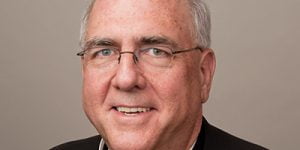by Archbishop Joseph F. Naumann
We are nearing the completion of our Lenten journey. During the Holy Week liturgies, we will actually touch the great events that changed the world forever. During the Palm Sunday liturgy, we will meditate upon St. Matthew’s account of the Passion. The Passion narrative contains the heart of the Gospel. Similar to St. Mark’s and St. Luke’s Passion accounts, St. Matthew brings home the humanity of Jesus and the depths of the suffering he endured to accomplish our redemption.
I encourage you to read and pray over St. Matthew’s Passion before attending Mass on Palm Sunday. Meditate on St. Matthew’s Passion throughout the first days of Holy Week. Ask the Holy Spirit to open your heart to the horror as well as the power and beauty of what happened on Calvary.
The approach of Holy Week inspires grateful memories of my recent pilgrimage to the Holy Land. One of the great highlights for any Christian pilgrim is a visit to the Church of the Holy Sepulcher.
The pilgrimage in which I was participating was sponsored by the Northern Lieutenancy of the Knights and Ladies of the Holy Sepulcher of Jerusalem for which I serve as the grand prior. The Knights and Ladies of the Holy Sepulcher trace their roots back to the Crusaders of the 11th century whose heroic efforts allowed access to the Holy Land for Christian pilgrims. The Knights of the Holy Sepulcher erected the church that to this day encloses both Calvary and the Empty Tomb.
During most of the day, the Church of the Holy Sepulcher is packed with pilgrims from all over the world. The best time to visit the church is in the early morning hours. On Sat., Oct. 23, at 4:30 a.m., accompanied by another priest, I went to the Church of the Holy Sepulcher. We ascended the stairway to the site of Calvary where there was only a handful of fellow pilgrims. It was an overwhelming experience to spend time at the actual place where Jesus gave his life for us. I had the opportunity to pray at the site of the crucifixion for almost an hour with very little distraction.
There are several different Christian groups who have been granted particular times during which they may pray at the place revered to be the location of the Resurrection. The Franciscans have been given responsibility for the care of all the Holy Land shrines for Latin-rite Catholics. Every day at 6 a.m., the Franciscans sing a solemn Mass at the site of the tomb of Jesus. On Oct. 23, I was given the distinct privilege of being the principal celebrant for this Mass.
The quarry that contained the tomb of Jesus was destroyed in the fourth century by the construction of a monument under the direction of the Emperor Constantine and his mother, Helena. However, the shelf upon which lay the body of Jesus remained. In the 19th century, an edifice was built with two chambers, the second of which encases the slab upon which the body of Jesus rested.
Appropriately, one must bow low to enter both chambers. There is only enough room in the inner chamber for three people. It is an unusual environment in which to celebrate Mass, because the congregation has to remain outside the edifice encasing the altar where the body of Jesus rested. The Liturgy of the Word is celebrated just outside the edifice. At the time of the preparation of gifts, I entered the inner chamber where I had to pray the Eucharistic prayer very loudly so that the congregation outside could hear.
In many ways, it was a surreal experience to offer Mass at the actual place of the events that every Eucharist makes present to us wherever it is celebrated. It drove home to me again that our Catholic faith is not just a theological theory, but it is founded on a historical person and actual events that took place in specific places.
The Holy Week liturgies and every Eucharist provide us with the same opportunity to encounter both the crucified One and the risen Lord as does a Mass celebrated in the Church of the Holy Sepulcher. Pope Benedict XVI reminds us often in his writing and preaching that our Catholic faith is not primarily a set of dogmas to be believed or even a set of moral principles to be lived, but rather an encounter with Jesus Christ. It is from being transformed by our friendship with Jesus that we find the inspiration to profess our creed and to strive to live a virtuous life.
I pray that this week will be a time when you encounter Jesus Christ anew and allow yourself to be transformed by the beauty of his love manifested on Calvary and renewed in the hope of his Easter victory of life. Without the rigors of an international flight, the liturgies of Holy Week offer us an opportunity, as powerful as a pilgrimage to the Holy Land, to touch the events that gave us life in Christ — to encounter anew the crucified and risen Lord!



